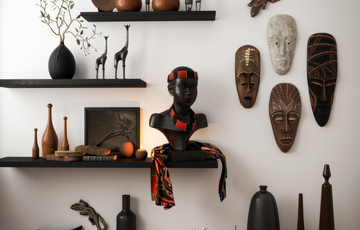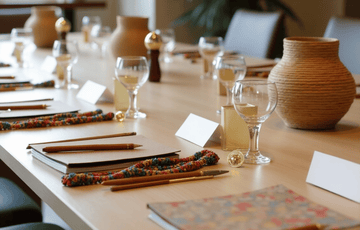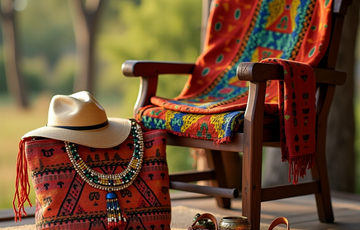In 2025, the African Union declared the theme of the year as “Justice for Africans and People of African Descent Through Reparations.” While reparations are often discussed in political and financial terms, there’s a powerful cultural dimension that deserves equal attention — representation.
One way everyday people can engage with this broader movement is by recognizing, respecting, and showcasing African heritage in their personal spaces. From handcrafted décor to fashion and functional art, African design is not just beautiful; it’s meaningful. And incorporating it into our homes is a conscious act of reclaiming narratives, celebrating cultural resilience, and supporting the artisans who are keeping ancient traditions alive
Why Representation Matters in Design
Representation in interior spaces is more than just aesthetic; it signals whose stories are being told and whose culture is being validated. For centuries, African design was either excluded from global design conversations or appropriated without acknowledgment. Now, as more people seek authenticity and heritage in their homes, African design is receiving long-overdue recognition , not as a trend, but as a cornerstone of global influence.
When African artistry is centered, not exoticized, not erased ; it becomes part of a larger cultural reparations movement. Every time you choose an African-made piece for your living room, bedroom, or kitchen, you're correcting an imbalance. You're affirming that African beauty, labor, and creativity have value, and always have.
African Design: A Legacy of Influence
African aesthetics have deeply influenced global art and design — often without credit. Consider:
-
Cubism, one of the 20th century’s most famous art movements, was heavily inspired by West African masks and sculpture. Artists like Picasso and Braque studied African carvings to break away from traditional European forms.
A side-by-side visual comparison that features a traditional West African mask alongside a Cubist-inspired artwork
-
Textile design, especially bold geometric prints, owes much to African traditions. Kente from Ghana, mud cloth (bogolanfini) from Mali, and Shweshwe from South Africa have been mirrored in international fashion houses from Dior to Stella McCartney.
-
Architecture and interiors have been shaped by African techniques like adobe building, woven partitions, and earth-toned palettes — echoed in modern sustainable design movements.
Yet, the artisans and communities behind these inspirations have historically seen little benefit. That’s why today, conscious consumers are choosing to source directly from African creators and brands that operate with transparency and fair trade principles.
How to Integrate African Design Into Your Home
Celebrating African heritage at home doesn’t require a complete overhaul. Thoughtful, intentional additions can transform a space while uplifting artisan communities. Here are some ideas:
1. Soapstone Sculptures & Bowls (Kenya)
Hand-carved in Kisii, Kenya, soapstone items like candle holders, bowls, and Easter eggs bring soft, grounded textures to any space. Each piece is uniquely carved and polished , a blend of functionality and art.
Hand-carved in Kisii, Kenya — each piece tells a story
2. Woven Baskets (Uganda, Rwanda, Ghana)
From banana fiber baskets in Uganda to vibrant Ghanaian bolga baskets, these can be used for storage, wall décor, or as statement centerpieces. Each region’s weaving style tells a different story of tribe, tradition, and daily life.
Handwoven heritage from Uganda, Rwanda & Ghana.
3. Textiles & Throws
Add warmth and culture to your sofas or beds with Kikoi cloth from Kenya, mud cloth from Mali, or Zulu beaded cushions from South Africa. The patterns often hold symbolic meaning related to ancestry, fertility, or community.
Textiles rich in story—crafted for comfort and culture.
4. Clay Ceramics & Planters (South Africa, Kenya)
Minimalist, earth-toned clay pieces bring natural texture to your home. Whether it’s a vase or planter, these items connect you to the continent’s long tradition of hand-built pottery.
Handcrafted ceramics that bring artistry and nature together on mawuafrica.com.
5. Beaded Décor & Accessories (Maasai & Zulu)
Beadwork is not only a fashion statement but a form of cultural expression. Use beaded coasters, napkin rings, or wall hangings to showcase intricate craftsmanship and support women-led artisan groups.
Vibrant beaded treasures, crafted with tradition and culture.
Representation as Reparations: Your Role
Buying African-made is more than a lifestyle choice — it’s a form of economic justice. It puts money directly into the hands of local creators, many of whom have been marginalized by global trade systems. It helps keep indigenous knowledge alive in an increasingly commercialized world. And it contributes to a narrative shift, where Africa is not just seen as a continent of need, but one of invention, beauty, and legacy.
By inviting African design into your home, you’re not just decorating , you’re participating in repair. You're making a political, cultural, and economic statement: Africa belongs at the table. Africa belongs in the story. Africa belongs in every home.
Celebrate Africa Month with Mawu Africa
At Mawu Africa, we work with over 1,000 artisans across Kenya, Uganda, Tanzania, the DRC, and South Africa. Each product we offer is handcrafted, ethically sourced, and steeped in cultural meaning. Whether you’re gifting, decorating, or simply exploring, our collections are an invitation to connect — to the makers, to the culture, and to the movement for justice.
Shop consciously. Represent proudly. Celebrate Africa, every day.





